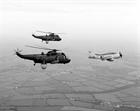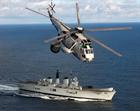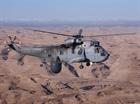60 Years of Airborne Early Warning
Not only does Her Majesty the Queen celebrate 60 glorious years as our Monarch this year, but a key element of today’s modern Royal Navy also shares this auspicious anniversary. Now affectionately known as the ‘baggers’, Naval Airborne Early Warning has recently celebrated its own Diamond Jubilee.
The first dedicated Airborne Early Warning Unit, also known as the ‘eyes of the fleet’ detecting enemies from far away, was commissioned in July 1952. 849 Naval Air Squadron first took to the skies flying the Douglas Skyraider, which was replaced by the Gannet aircraft in 1960 and ultimately became one of the Royal Navy’s longest serving front line aircraft. 849 Naval Air Squadron was the sole operator of the aircraft until the mid-1970s when the last fixed wing carrier, HMS Ark Royal IV, was decommissioned in 1978. The demise of HMS Ark Royal in 1978 marked the end for 849, which was duly disbanded in the same year.
The need for an Airborne Early Warning capability within the Royal Navy was highlighted in the Falklands conflict and consequently in a very short 11 week period, two Sea King airframes were converted and deployed to the Falklands. By November 1984, 849 Squadron reformed as the Royal Navy’s primary Airborne Early Warning asset, this time employing the Sea King Mk 2 as its airframe.
The Sea King Mk 2 served the Royal Navy providing support for both the Sea Harrier FRS 1 and FA 2 until 2003. By 2002 the Sea King Mk 2’s successor, the Sea King Airborne Surveillance and Control (ASaC) Mk 7 was introduced into service with its new Searchwater 2000 radar system. The first real test for this new system came in Gulf War 2. During the 2003 invasion, helicopter crews from 849 Squadron operated from the flagship of the Royal Navy Task Force, HMS Ark Royal, where their ‘overland’ radar capabilities gave commanders on the ground the ability to monitor activity.
The Sea King (ASaC) Mk 7 has continued to provide surveillance for the Royal Navy since then, and has been involved in anti piracy operations in the Middle East as well as anti drug operations in the Caribbean. More recently Sea King aircraft from Culdrose have been heavily involved in providing land surveillance for ground forces in Afghanistan. The Operation Herrick commitment endures to this day and the Squadrons deployed by Royal Naval Air Station Culdrose, are regularly credited with actions and intelligence leading to significant hauls of insurgent money, drugs and bomb making equipment.
The flexibility and professionalism of the Sea King ASaC force (now made up of 854, 857 and 849 Squadrons) has been more recently tested during the Libya conflict and the rapid ‘re-role’ from operating on an exercise in the Mediterranean to supporting maritime operations on the frontline. Sea King ASaC Mk 7s from 854 Naval Air Squadron also played a pivotal role in air cover during London 2012 which enabled a safe and secure games.
To celebrate the 60th anniversary of 849 Naval Air Squadron as an Airborne Early Warning Unit, in September this year the Sea King (ASaC) Force at Royal Naval Air Station Culdrose opened the doors of its new ‘Palembang Building’ to ex and serving members of the Airborne Early Warning community. The celebrations also tied in with the 30th anniversary of the inception of the Sea King MK2, along with the 10th anniversary of the current Sea King (ASaC) Mk7. The Guest of Honour at the celebrations was Lt Cdr Peter Hiles (Rtd), the first Senior Pilot of the newly re-commissioned 849 Naval Air Squadron in 1952. Lt Cdr Hiles delighted guests with stories about flying the Skyraider, including one particular flight where his engine stopped far out to sea and having ‘racked his brains a little’ he brought the engine back to life by continually pressing the priming pump button. He got the aircraft back to Culdrose safely with an index finger the size of a golf ball.




